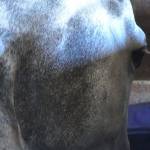Molasses used in Horse Feed for Palatability and Energy

Despite its undisputed popularity with the four-legged, whinnying set, molasses often gets a bum rap by horse owners. The gooey goodness has been blamed for a myriad of problems including hyperactivity.
Is there any truth to the assertion that molasses can make horses flighty?
Molasses is an ingredient in the majority of textured (or sweet) feeds. Although it is most recognizable in textured feeds, feed manufacturers also incorporate molasses into pelleted concentrates to enhance palatability. The volume of molasses in pelleted feeds, however, is usually significantly less than hat used in textured feeds.
Molasses supplies horses with digestible energy because it is composed almost entirely of sucrose, glucose, and fructose, sugars that are readily absorbed from the digestive tract.
The amount of molasses in a typical helping of a textured feed cannot, however, induce hyperactivity. Depending upon the specific formulation, textured feeds contain approximately 4-10% molasses. If a one-ton batch of feed, for example, contains 7%, 140 pounds of the final product would be molasses. Assuming a gallon of molasses weighs approximately 11.7 pounds, this equates to about 12 gallons of molasses for the entire batch. From a practical perspective, a five-pound meal of this concentrate would contain 0.35 pound of molasses.
Instead of singling out molasses as the cause of excitability, the sum of all energy sources, as well as the management of a particular horse, must be taken into consideration when searching for reasons for hyperactivity. Often the total amount of feed offered (including hay), rather than the makeup of the concentrate, is the primary contributor to hyperactivity. The majority of concentrates formulated for horses contain a variety of energy sources. Energy is most generously afforded by cereal grains such as oats, corn, and barley. These starch-laden ingredients contain more digestible energy than an equal weight of molasses.
More and more feed manufacturers are creating feeds designed especially for hard-to-handle horses that require energy-rich feedstuffs to perform optimally. Instead of using traditional starch-filled energy sources such as cereal grains, feed manufacturers have turned to fat and fiber. Fat provides 2.25 times more digestible energy than an equal weight of carbohydrate or protein. Examples of fat include vegetable oils such as soybean oil and corn oil. Some feed manufacturers have added rice bran to their feeds to raise energy levels. The addition of super fibers, so named because they provide considerably more energy than ordinary fibrous feedstuffs such as hay, are also included in these feeds. The most popular super fiber is beet pulp, but others including soy hulls are used.
One example of a high-fat, low-starch feed is Re-Leve. Formulated by Kentucky Equine Research, Re-Leve is designed for horses prone to tying up, hyperactivity, and other problems associated with a starch-rich diet. This incredibly palatable feed contains fat from corn oil and rice bran and fiber in the form of shredded beet pulp and soy hulls.
If a feed manufacturer does not make a low-starch feed specifically for performance horses, consider using a feed designed for aged horses. These “senior feeds” usually contain energy-dense ingredients such as oil and beet pulp. Feeds that contain heaps of alternative energy sources are often called “cool feeds” because they reduce feed-related hyperactivity. Most cool feeds are mixed with molasses to ensure palatability. In fact, many feeds that contain large amounts of beet pulp actually have more molasses than ordinary textured feeds, yet they are still considered cool feeds.
In addition to the type and amount of concentrate being fed, owners of hyperactive horses should look at other areas of management. Horses that are kept in a stall or small corral much of the day will likely be more difficult to handle than horses that have more liberal access to free exercise. Full-time turnout and regular work are sometimes all that is necessary to curtail the expression of excess energy.
Horse owners should look beyond molasses when searching for a cause of misbehavior. Although nervousness and hyperactivity may be related to feeding management, the problem usually can’t be traced to the amount of molasses being consumed.








